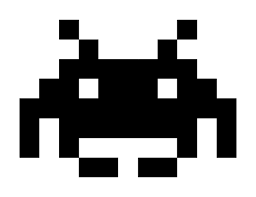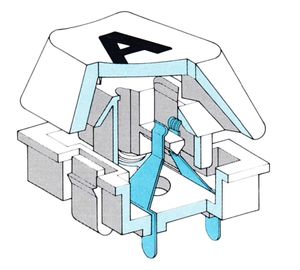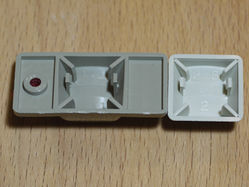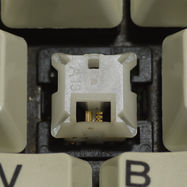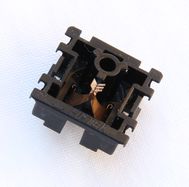User:Engicoder
That red font color was driving me crazy!!
v1.8
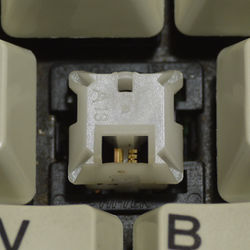 | |
| Manufacturer | Hi-Tek |
|---|---|
| Introduced | 1983 |
| Discontinued | 1995 or later |
| Switch type | Clicky; tactile; linear; latching |
| Sense method | Metal leaf |
| Patents | EP0124206 (1984) |
Hi-Tek Series 725 is the name Hi-Tek Corporation used for a low-profile keyboard series designed to be DIN-compliant and introduced in 1983. The "725" in name refers to the 0.725" distance from top of the keycap to the keyswitch PCB. "Series 725" also refers to the switches used in these keyboards.
Contents
Series 725 keyboards
Series 725 was introduced by Hi-Tek shortly before their acquisition by Minebea. The name does not refer to any particular size or shape of keyboard, but rather to the reduction in desk-to-keycap height that was made possible by the use of compact switches.
See:
- Hi-Tek Series 725 first generation: typically Model F clone layout
- Hi-Tek Series 725 second generation: typically Model F clone layout
- NMB RT-100/RT-8200 series: full-size keyboards; later variants gained Windows keys
Series 725 switches
Series 725 is a family of metal contact switches designed by Hi-Tek Corporation in the early 1980s, and patented post-introduction in 1984[1]. Series 725 switches are used primarily, if not solely, in keyboards manufactured by Hi-Tek and NMB. Series 725 switches are commonly known as space invader switches, due to their resemblance to the enemy characters in Taito Corporation's Space Invaders game from the late 1970s. The Chinese name for them is "怒熊", translating to Fury Bear or Angry Bear. The series was also referred to as NMB Hi-Tek when the relationship between Hi-Tek and NMB was not known.
Construction
Series 725 switches are notable for having a particularly unusual keycap mount — the slider is large and flat-topped and the keycap clips over the top. The return spring reaches to the top of the slider, meaning that the keycap sits over and around the slider, reducing the height requirement of the keyboard significantly while retaining full travel (the switches are specifically patented as "low profile"). As a result, there is no upper shell, as the slider also serves this purpose.
Like the previous Hi-Tek High Profile switches, the slider contains a horizontal plastic bar that holds apart a pair of vertical electrical contacts, which close together when the slider is depressed or removed from the switch. Each contact has two legs, for a total of four arranged in a square. The legs are press fit into the lower housing. The movement of the slider is controlled by a central tri-lobed guide post in the lower housing which slides within a matching cavity in the slider. This post allows a vertical sliding motion while preventing any rotation. A center bore in this guide post locates the spring and prevents buckling. A small lug in the slider provides a seat for the upper end of the return spring to prevent lateral movement. The slider is retained in the lower housing by a set of flexible tabs on the slider which fit into slots in the lower housing.
<< insert labeled pics of switch components >>
Variations
Linear
The Series 725 switch was designed as a linear type and commonly found in early keyboards as well as those used with computer terminals.
Tactile
The tactile variant of the Series 725 switch is the least common of the three standard types. Tactility is provided by the contact leaves. The contact leaves have a indentation on each arm which narrows the spacing between the two contact arms. As the slider is depressed, the contact separator bar moves through this narrowing, pushing the contact arms apart before allowing the contacts to touch. This spring of the contact arms provides increased resistance generating tactility on both the down-stroke and upstroke, with the upstroke being slightly more pronounced. The contact separator bar within the slider is narrower than that of the linear variant. The return spring of the tactile variant is slightly shorter and has less active coils than that of the linear version.
Clicky
The clicky variant of the Series 725 switch was introduced in the late 80s and became the most common variant found in later keyboards. The click is achieved by way of a plastic follower arm that runs inside an track integrated into the rear of the slider. When the slider is depressed, the follower or click arm travels up the track and over a ramp creating an audible click sound. [2] This follower arm is plainly visible and accessible without needing to dismantle the switch. This arm also provides a small amount of tactility. in order to add the track added to the slider, the rear portion of the central guide post in the lower housing had to be flattened on one side. The click variant uses the same spring and contact arms as those used in the linear version.
Spacebar
The spacebar variant exists as linear, tactile and clicky versions. They are identical to their standard counterparts of the same type other than the spring. The spring used in the spacebar variant is longer which results an increase in the force required to depress the switch. These switches are often marked with painted dot, presumably used to differentiate them from standard switches during production.
Latching/Alternate action
The latching, or alternate action variant of the Series 725 switch is uncommon, only being found in a few earlier keyboards. The latching mechanism consists of a pivoting latch arm mounted in the lower housing that runs in a one way track in the slider. The track design is heart shaped and incorporates a series of ramps to ensure the latch arm is only able to travel in one direction. Once the switch is depressed, and a central v-shaped block traps the latch arm in the depressed state. Pressing the switch a second time forces the latch arm to continue the one way path and return to the released position. This heart shaped track design is similar to that seen in other latching switch designs.
Integrated LED
The integrated LED variant of the Series 725 switch integrates a 3mm round LED into the lower housing that is visible through a circular window in the keycap. The LED can be physically located in either the NE or NW corner of the switch, but the only know windowed keycaps use the NE position. To accommodate the LED, the slider was designed with a tapered shape. Linear, tactile and clicky versions of the integrated LED switch exist.
Evolution
The design of the switch evolved with time. The initial linear switch design was adapted improve keycap retention as well as add tactile and clicky versions.
Slider
The first Series 725 switches were linear and used a slider with a single round "eye" large, rounded "mouth" opening. This "soap dispenser" or "Gundam" design is depicted in Hi-Tek's switch patent for the Series 725 switch. Keycaps were held in place by a friction fit between slots in the slider and matching tabs on the inside of the keycap.
<<insert pics of switch and keycaps>>
The large "mouth" opening was replaced by a smaller rectangular opening, while the "eye" shape and keycap retention remained the same.
<< insert pics of switch>>
The eye shape was changed to a square shape with the introduction of the first tactile switch. Keycap retention remained the same.
<< insert pics of switch>>
The slider design was updated to provide snap on keycap retention by adding small ramps to the sides of the slider that engaged flexible tabs added to the keycaps. This new design used the single square eye shape and was used for both linear and tactile types.
<< insert pics of switch and keycaps>
Housings
<<desribe two housing styles with pics>>
Spring
As with the earlier Hi-Tek switches, the return spring has a tight cluster of turns in the centre as well as at each end.
Keyboards with Series 725 switches typically use a different switch for the space bar. The only difference is that the spring is longer, resulting in a stiffer switch.[3]
Stabilizers
Series 725 switches also use custom stabilisers where the custom-shaped stabilizer wire clips directly under the switch shell.[4]
There is two main types of stabilizers. Wire stabilizers clip into the switch housings and are the most common stabilizer found within 725 series keyboards.
NMB Plate mount stabilizers which are found in keyboards in later generations. Plate mount stabilizers clip into the keycap and slide into clips that are inserted into the plate of the keyboard.
Keyboards
- ADDS ASCII
- ADDS PC+
- ADDS VT220
- Ampex 220
- Ampex 230
- Atari PC1 8008
- Commodore Amiga 2000
- Commodore Amiga 500
- Commodore PC-5/PC-10 keyboard
- Corona PPC-400
- ICL DRS
- Kroy 190
- Kroy 360
- N-97SYS
- NCD N-108
- NCD RT-101
(Also see NMB Keyboards)
- Early Commodore Amiga 500 keyboards (white linear)
- Some Commodore Amiga 2000 keyboards (white linear)
- Some Commodore PC-5/PC-10 keyboards (white linear)
- Lynk PC122 (grey tactile, and possibly others)[5]
- Memorex Telex NMB Hi-Tek (black, with brown or blue for space bar)
- NCR 4940 (white linear)
- NCR 4950 (two-eye white or two-eye non-click black)
- NMB RT-100/RT-8200 series (wide variety)
- NMB HI-TEK Series 725 122-key (white linear)
- Philips P2812 (all white linear)
- Some Symbolics 365407 (grey and/or white)[6][7]
- Unknown 122-key keyboard with NMB branded PCB (black, possibly clicky)[8]
Gallery
Linear
White two-eye click track slider with click arms omitted[9]
Tactile
Tactile grey switches from model RT 101+INTEL[10]
Clicky
Black switches with cyan for space bar, from RT8255CW+[11]
Integrated LED
External links
References
- ↑ Google Patents — Low profile keyswitch
- ↑ YouTube — NMB Hi-Tek Trailing arm click
- ↑ geekhack — Nmb rt-8251t
- ↑ Deskthority — NMB RT101+
- ↑ webwit.nl — Index of /input/lynk
- ↑ Deskthority — The Lisp keyboards
- ↑ Abstract Science Ltd — Symbolics Keyboard internals (PN 365407 Rev C)
- ↑ Deskthority — Hi-Tek Corp. History
- ↑ Sandy — NMB RT101+ WL
- ↑ MouseFan — RT 101+INTEL
- ↑ MouseFan — RT8255CW+ 104AT Thailand
Cite error: <ref> tag with name "Commodore" defined in <references> is not used in prior text.
Cite error: <ref> tag with name "rzwv-sliders" defined in <references> is not used in prior text.
Cite error: <ref> tag with name "gh-RT101-white-click" defined in <references> is not used in prior text.
Cite error: <ref> tag with name "DT-white-linear" defined in <references> is not used in prior text.
Cite error: <ref> tag with name "Sandy-N-97-KANA" defined in <references> is not used in prior text.
Cite error: <ref> tag with name "P2812" defined in <references> is not used in prior text.
Cite error: <ref> tag with name "laugh" defined in <references> is not used in prior text.
Cite error: <ref> tag with name "KBDMania-Memorex" defined in <references> is not used in prior text.
